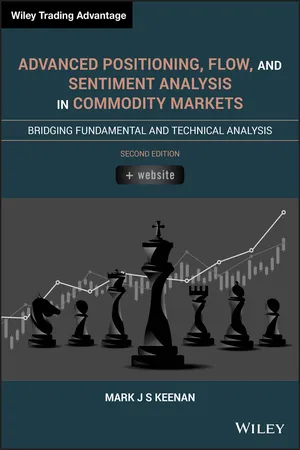
Advanced Positioning, Flow, and Sentiment Analysis in Commodity Markets
Bridging Fundamental and Technical Analysis
- English
- ePUB (mobile friendly)
- Available on iOS & Android
Advanced Positioning, Flow, and Sentiment Analysis in Commodity Markets
Bridging Fundamental and Technical Analysis
About this book
The definitive book on Positioning Analysis — a powerful and sophisticated framework to help traders, investors and risk managers better understand commodity markets
Positioning Analysis is a powerful framework to better understand commodity price dynamics, risk, and sentiment. It indicates what each category of trader is doing—what they are trading, how much they are trading and how they might behave under a variety of different circumstances. It is essential in isolating specific types of flow patterns, defining behavioral responses, measuring shifts in sentiment, and developing tools for better risk management. Advanced Positioning, Flow and Sentiment Analysis in Commodity Markets explains the fundamentals of Positioning Analysis and presents new concepts in Commodity Positioning Analytics. This invaluable guide helps readers recognize how certain types of positioning patterns can be used to develop models, indicators, and analyses that can be used to enhance performance.
This updated second edition contains substantial new material, including analytics based on the analysis of flow, the decomposition of trading flows, trading activity in the Chinese commodity markets, and the inclusion of Newsflow into Positioning Analysis. Author: Mark J S Keenan, also covers the structure of positioning data, performance attribution of speculators, sentiment analysis and the identification of price risks and behavioral patterns that can be used to generate trading signals.. This must-have resource:
- Offers intuitive and accessible guidance to commodity market participants and risk managers at various levels and diverse areas of the market
- Provides a wide range of analytics that can be used directly or integrated into a variety of different commodity-related trading, investment, and risk management programs
- Features an online platform comprising a wide range of customizable, regularly-updated analytical tools
- Contains an abundance of exceptional graphics, charts, and illustrations
- Includes easy-to-follow instructions for building analytics.
Advanced Positioning, Flow and Sentiment Analysis in Commodity Markets: Bridging Fundamental and Technical Analysis, 2 nd Edition is an indispensable source of information for all types of commodity traders, investors, and speculators, as well as investors in other asset classes who look to the commodity markets for price information.
Frequently asked questions
- Essential is ideal for learners and professionals who enjoy exploring a wide range of subjects. Access the Essential Library with 800,000+ trusted titles and best-sellers across business, personal growth, and the humanities. Includes unlimited reading time and Standard Read Aloud voice.
- Complete: Perfect for advanced learners and researchers needing full, unrestricted access. Unlock 1.4M+ books across hundreds of subjects, including academic and specialized titles. The Complete Plan also includes advanced features like Premium Read Aloud and Research Assistant.
Please note we cannot support devices running on iOS 13 and Android 7 or earlier. Learn more about using the app.
Information
CHAPTER 1
Advanced Positioning, Flow, and Sentiment Analysis in Commodity Markets
Chapter objectives
- 1.1 Positioning Analysis – What Is It?
- 1.2 The History of Positioning Data, the COT Report, and the Agencies that Provide the Data
- 1.3 Misunderstandings and Issues in Positioning Analysis
- 1.4 Futures and Options Data
1.1 Positioning Analysis – What Is It?
1.1.1 Positioning Data
1.1.2 Positioning Analysis – Bridging Fundamental and Technical Analysis
1.1.3 Positioning Signals, Indicators, Models, and Analyses
1.2 The History of Positioning Data, the COT Report, and the Agencies that Provide the Data
1.3 Misunderstandings and Issues in Positioning Analysis
Table of contents
- Cover
- Table of Contents
- ABOUT THE AUTHOR
- ACKNOWLEDGEMENTS
- PREFACE
- ABOUT THE COMPANION WEBSITE
- INTRODUCTION
- CHAPTER 1: Advanced Positioning, Flow, and Sentiment Analysis in Commodity Markets
- CHAPTER 2: The Structure of the Positioning Data
- CHAPTER 3: Performance Attribution – An Insight into Sentiment and Behavioural Analysis?
- CHAPTER 4: Concentration, Clustering, and Position Size – Price Risks and Behavioural Patterns
- CHAPTER 5: ‘Dry Powder (DP)’ Analysis – An Alternative Way to Visualise Positioning
- CHAPTER 6: Advanced DP Analysis – Deeper Insights and More Variables
- CHAPTER 7: Decomposing Trading Flow and Quantifying Position Dynamics
- CHAPTER 8: Overbought/Oversold (OBOS) Analysis – The Intersection of Extremes
- CHAPTER 9: Advanced OBOS Analysis – Extremes in Sentiment and Risk
- CHAPTER 10: Sentiment Analysis – Sentiment Indices and Positioning Mismatches
- CHAPTER 11: Newsflow in Positioning Analysis
- CHAPTER 12: Flow Analysis – The ‘Flow Cube’ and the ‘Build Ratio’ in Commodity Markets
- CHAPTER 13: Chinese Commodity Markets – Analysing Flow
- CHAPTER 14: Machine Learning – A Machine's Perspective on Positioning
- APPENDIX 1: History of the COT ReportHistory of the COT Report
- APPENDIX 2: The COT ReportsThe COT Reports
- INDEX
- End User License Agreement